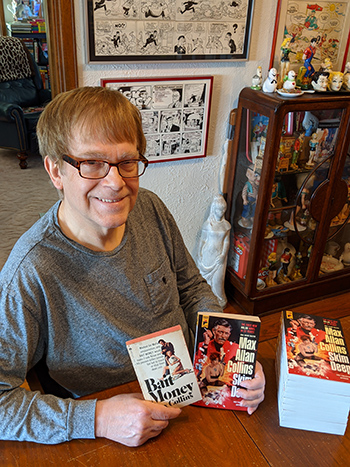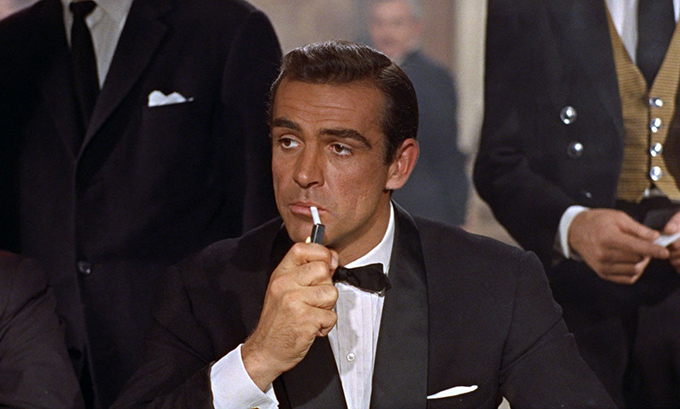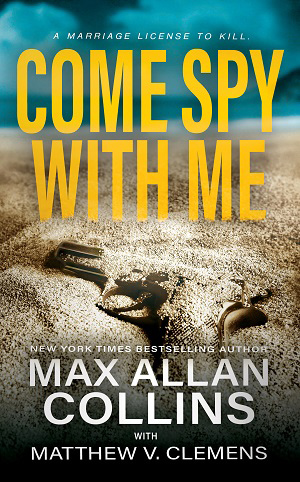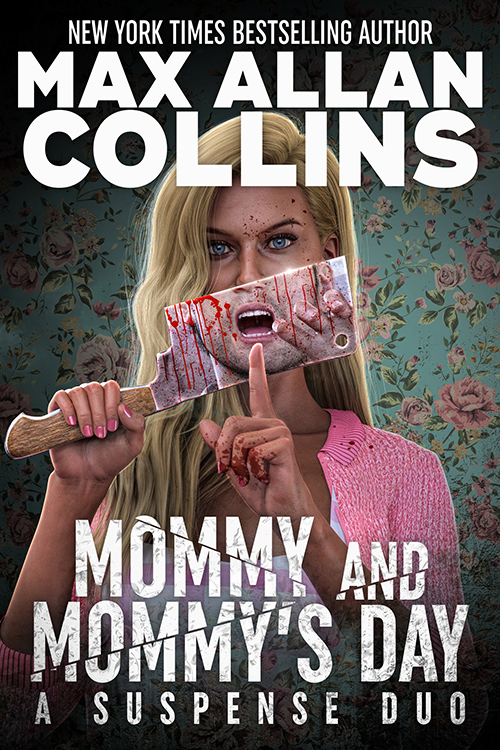First, here’s another interview of me by the great Andrew Sumner for Titan Books – this time regarding Nolan and Skim Deep.
Okay, show of hands – how many of you like books?
Seems to be everybody.
All right, how many of you like free books? Don’t fight!
Only so many free books are on hand, so how many of you like a really good bargain? Don’t pout! I mean, really good….
The entire Reeder and Rogers trilogy by Matt Clemens and me is on sale right now as part of Amazon’s Monthly Deals: Up to 80% off Kindle books. They will stay on sale till 11-30-2020, with [Amazon links:] Executive Order at $1.99 and Supreme Justice and Fate of the Union available at 99 cents each.
But wait, there’s more! (Look, I realize I shifted from classroom mode to infomercial, but I figure you can stay with me.)
The first of the two (so far) Krista Larson novels, Girl Most Likely (a Thriller Award best paperback nominee), is part of that same sale for just 99 cents.
Now for the free books. Don’t rush the stage! (Yes, I know, I did it again. Pretend it’s a running joke.)
I have ten copies of Skim Deep, the first new Nolan book in over three decades.
[All copies have been claimed! Thank you for your support. — Nate]
This doesn’t come out till Dec. 8, but I have these ten finished copies of the novel provided by Hard Case Crime. You’ll see me here posing happily with Skim Deep, the final Nolan novel, and the original edition of Bait Money, the first Nolan novel, published in December 1972.
That’s 48 years ago. Nolan is 48 years old in Bait Money, by the way, which at the time seemed really old to me. Those two 48-year periods represent one of those insignificant facts that take on weight in a barroom after enough time and tide has passed.
I’m going to walk you through how Nolan came to be. Some of you will have heard me talk about this, and/or write about it before, but go on reading – with my memory, it’s sure to come out different.
I started reading Richard Stark in 1967 after the film Point Blank came out, based on The Hunter, the first in a series about professional thief, Parker. Around the same time I discovered another writer, comic mystery author Donald E. Westlake, and these two were soon my favorites of then-current mystery writers. I had no idea Westlake was Stark – their books were so very different.
Westlake/Stark was the last author to have a major impact on my work. I was already reading Spillane, James M. Cain, Dashiell Hammett, Raymond Chandler, Ed McBain and Jim Thompson (and a few others). I had basically trained to be a writer of private eye novels or maybe cop books, but the times they were a changin’, and P.I.s were impossible to sell and, in 1968, cops were just guys clubbing my friends at the Democratic convention.
I’d already discovered an obscure series by Ennis Willie about an ex-hood named Sand, who had much in common with Stark’s Parker, though Sand was created first. A tough guy who was an ex-hood heist artist seemed a reasonable alternative to gumshoes. Hence, anti-heroes. Crook books.
A few paragraphs ago I called Bait Money the first Nolan novel. It kind of wasn’t. The same character, originally called Cord in a book titled Mourn the Living, I’d written in junior college. It didn’t sell, but it got me into the University of Iowa Writers Workshop thanks to Richard Yates, the great mainstream novelist.
Bait Money (and the first Mallory, No Cure for Death) were written for Yates and his class, and he worked one-on-one with me even after I was required to study with a few other instructors. He landed me an agent, Knox Burger, who had been a well-known editor at Collier’s and then Gold Medal Books. Among other things, Burger was instrumental in talking John D. MacDonald into creating Travis McGee.
Yates sent Burger Bait Money and praised me as a young Dashiell Hammett or Raymond Chandler. Burger, who was as no-nonsense as a hit-and-run driver, said, “More like a young W.R. Burnett.” Which was fine with me. In the same league as the guy who wrote Little Caesar, High Sierra and Asphalt Jungle? I understood how great that was, even if Yates didn’t.
Burger is the guy who called me a blacksmith in an automotive age. Again – fine by me.
I killed Nolan on the last page of Bait Money and Burger wanted me to un-kill him. I refused, but the book kept getting rejected. Then an editor at Pyramid Books spilled coffee on the manuscript, meaning I had to retype it (which I did, myself). Burger said, “You might as well take the opportunity to put the better ending on.”
I did.
It sold next time out and the editor wanted a series. This was a problem because I had conceived Bait Money as an homage to Richard Stark, or even a pastiche, using his distinctive method of organizing sections and using strict point of view.
I had, by this time, begun to correspond with Don Westlake. He began mentoring me, and had read Bait Money (Burger gave the manuscript to him) and professed to like it. I wrote Don and asked him how he felt about me doing a series about Nolan – I was uncomfortable because (as many of you have heard me say) homage is French for rip-off.
Don graciously insisted that the Jon character – the sort of hippie-ish comic book collecting “kid” who became Nolan’s surrogate son – made the books more human. Don also felt Nolan was more overtly human than Parker. He said by all means take the gig.
I did. The publisher was Curtis Books, an off-shoot of the same company that had published the enormously successful Saturday Evening Post. Their paperback line, however, was not enormously successful. I did four Nolan novels and the first two Mallory books for them, and they only published the first two Nolans (and neither Mallory) before Popular Library bought them out.
The editor at Popular Library put the books into inventory, while periodically insisting publication was imminent. It never happened. Meanwhile, I wrote Quarry (originally The Broker) and Berkley Books bought it and asked for three more.
In the early ‘80s, Knox Burger sold all five Nolan novels to Pinnacle, plus a new to-be-written one. They had recently lost the Mack Bolan series and apparently I was supposed to be the replacement, though Bolan and Nolan had nothing in common but rhyming.
I had to revise the first two novels somewhat, largely because Fly Paper pre-dated quite a few airport security measures. Bait Money came out and sold very well.
Then the creator of Mack Bolan, Don Pendleton, threatened to sue Pinnacle for publishing a series about somebody who rhymed with his character. So the last couple of books had Nolan’s name taken off the covers, and my contract was dropped.
My novel True Detective got some me some attention in 1983, and a few years later an editor at TOR asked me to revive Nolan, which I did with Spree. But then, for reasons not worth going into, that editor and I had a falling out and a contract to do a bunch more Nolans got dropped.
Seems Nolan and Jon led at least as perilous a life in the world of publishing as they did in fictional crime.
That was it for Nolan until, finally, Mourn the Living was published, with “Cord” changed to “Nolan.” Writer Wayne Dundee had serialized the novel in his magazine Hardboiled, and people started asking me to collect it in book form. I did. It was a hardcover from Five Star.
Felt like Nolan had come full circle, from Bait Money to the unintentional, Jon-less prequel, Mourn the Living.
Then, as is his habit in my publishing life, Charles Ardai came along. He was going to do some reprints and a few new books for his budding Hard Case Crime line. He was a fan of the second Nolan novel, Blood Money, and wanted to publish it. I felt Bait Money ought to be included, as Blood Money was its sequel. He put them together as Two for the Money.
As most of you know, I revived Quarry for Charles, who from time to time asked me to consider writing a new Nolan. I resisted, because I’d written Spree to be the last book. Finally he offered to republish all of the Nolans (two books to a volume) with spiffy retro covers if I’d do a new one.
And, so, all these years later, I have.
What was most interesting to me was that despite the many decades gone by, when I sat down to write about Nolan and Jon, bing! There they were. Waiting for me to check back in with them. I don’t know why it came so easy. It’s not like I haven’t written about other characters in the interim.
But Nolan in Mourn the Living, and Nolan and Jon in Bait Money, represented the start of my career, and both books took a lot of time. I’m known, I guess, for being able to turn out good books in not much time. But those first two novels were where I went to school, teaching myself (and cribbing from Stark and the rest).
Back then, I had to type pages over and over, because there were no photocopy machines yet and publishers got their noses out of joint if you sent a carbon copy. I would imagine I worked on Bait Money for a year and a half. Skim Deep took, I believe, three weeks. Maybe a month – I don’t really keep track.
So now Nolan has come full circle, and maybe so have I, and like Nolan, I have no intention of dying on the last page.
* * *
Here’s some nice love for the forthcoming Shootout at Sugar Creek, the new Caleb York.
M.A.C.












